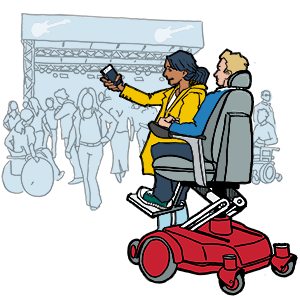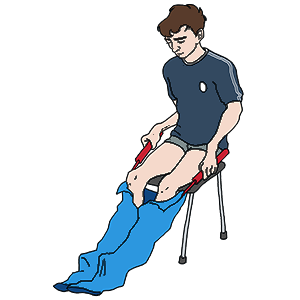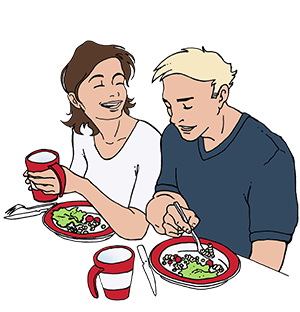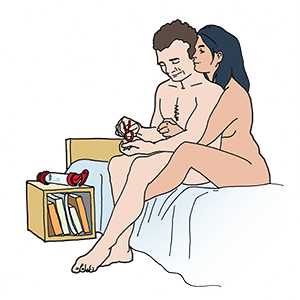Muscular Dystrophy - Adults
Last updated 27-10-2020 It is individual which assistive products that are relevant for you if you have muscular dystrophy. This article gives an insight into assistive products for mobility, personal hygiene, communication, sitting and lying positions, and other daily activities.
It is individual which assistive products that are relevant for you if you have muscular dystrophy. This article gives an insight into assistive products for mobility, personal hygiene, communication, sitting and lying positions, and other daily activities.Muscular dystrophy is a generic term for a line of neuromuscular diseases, which affect the interaction between nerves and muscles. There is a big difference to which degree your functional capacity is affected due to the muscular dystrophy. Therefore, there is a big variation in which assistive products you will benefit the most from. Many of the assistive products can make you able to perform activities with less muscle power.
As muscular dystrophy develops over time, it is necessary to take the progressive aspects of the diagnosis into consideration when choosing assistive products.
In this target group entry, we describe assistive products for adults with muscular dystrophy. If you seek information on assistive products for children with muscular dystrophy, please look into the target group entry on Muscular Dystrophy - Children.
Assistive products for respiration are not included in this article.
Getting around
If you have limited or no walking ability, there is a range of assistive products that can support you. The assistive products in the following are divided into categories listed by your means of getting around: walking, in a wheelchair, or on a bike, a scooter, or similar.
Getting around by feet
If you have an uncertain gait – or need an extra point of support point – there is a variety of walking sticks offering various degree of support. The most used are hand-held walking sticks or elbow crutches. The walking sticks have different weights and more or less comfort and support in the handgrips. To be able to walk with a walking stick, it requires that you can make lateral weight transfers, which can be challenging for some persons with muscular dystrophy. Please consult a physio- or occupational therapist before you get a walking stick.
You can read more in the guide Walking sticks.
If you need more support than a walking stick can give you, a rollator (with forearm support if necessary) may be a possibility.
In AssistData, you can search for rollators and filter the product list by features such as weight, whether they are for outdoor or indoor use, and whether or not they have a seat. By doing that you can find the rollator suiting your needs best.
When trying a rollator, you need to test if you can walk without bumping into the rollator’s wheels especially if you have a broad gait or swing outwards with your legs when walking. A rollator with forearm support can support you more and give you a more upright gait than a regular rollator gives you.
Walking with a rollator often requires that you can lean your weight forward. There is also posterior rollators that can be pulled behind you. These types are especially relevant if you need to walk upright. Even though many people use rollators, it is not easy to choose the right one. Therefore, please consult a physio- or occupational therapist before acquiring a rollator.
- Rollators with four wheels, to be pushed
- Rollators with forearm support
- Rollators with four wheels, to be pulled
Read more in the guide Rollators.
Getting around in a wheelchair
If you can only take few steps, have lost your gait function entirely, or experience quickly to get exhausted and fatigued when standing or walking, you can benefit from a manual or powered wheelchair.
A manual wheelchair is propelled and steered forward on the big wheels or pushed by a helper. It requires quite some power to move a manual wheelchair forward by yourself, especially if the surface is not even. The settings of the wheelchair, e.g. the wheel’s position in relation to the center of gravity, affects the efforts it takes to move the wheelchair. Therefore, it is important to get a professional to do the settings of the wheelchair. The wheelchair can also have a user operated propulsion unit mounted to reduce the amount of force needed.
A powered wheelchair is usually steered by using a joystick and can be propelled and steered with minimal force. The wheelchair can be set to fit your needs regarding propelling and steering, depending on what works best for you, e.g. a micro-joystick, lip or chin control, 0/1 switch, and assistant steering. A powered wheelchair comes with electrical settings for the seating such as height (for getting in or out of the wheelchair and rising to a standing position), seat tilt or back recline. A powered wheelchair can be taken into a minibus. With most powered wheelchairs, you will be able to sit in it during transportation.
Both the manual and the powered wheelchair must be adjusted individually, so you get the best support while sitting and the best possibilities for propelling and steering the wheelchair. Since your functional ability changes over, it is important that a professional regularly adjust your wheelchair to make sure that it continuously supports you in activity and rest.
A manual wheelchair can be a supplement if you need to go somewhere, where it is not possible to use the powered wheelchair. Therefore, it can be relevant to have both types of wheelchair.
- Manual wheelchairs
- Powered wheelchairs
- Propulsion units for wheelchairs
- Steering and control systems for wheelchairs
- Modular wheelchair seats
Getting around on a bike, powered scooter or similar
If you do not use a wheelchair and need to get further around than you can walk, a powered bike, a three-wheeled bike (a tricycle), a scooter or a powered scooter may be the solution for you. There is different types of powered bikes or three wheeled bikes, e.g. with low entry so you do not have to lift your leg high to climb onto the bike. It is important to be able to place the seat in a high and horizontal position on all means of transportation in order for you to use minimal muscle power to get up from the seat.
- Foot-propelled bicycles
- Foot-propelled tricycles and quadricycles
- Powered wheelchairs and scooters
- Unpowered scooters propelled by pushing with one foot
- Stand-on motorized vehicles
Please read more in the guide Tricycles and in the guide Powered Scooters
Toileting and Bathing
A variety of assistive products can support you when taking a bath or using the toilet. The assistive products can support you if you have a hard time standing safely due to slippery floors, if you have reduced ability to stand, or if you are not able wash yourself. There are also products that are helpful for other activities related to using a toilet or to personal hygiene.
In the shower
If you have reduced balance or you get fatigued from standing, it is important to have support when taking a shower. You can mount a supporting handrail or a grab bar in one or a few strategic places on the wall, which can help you maintain balance. A non-slip mat can be extra helpful. There is also a variety of assistive products designed to help you dose soap, wash your feet, hair, or back, control the showerhead and such when taking a shower.
A shower chair or a shower stool can be a good solution, so you can shower while sitting down. Shower chairs come with or without wheels and with or without back support and arm support. Alternatively, you can have a foldable shower seat mounted in your preferred height on the wall. If you have a hard time getting up after taking a shower, it can be a good idea to use a shower chair or a shower seat with electric height adjustability.
- Showers and shower units
- Supporting handrails and grab bars
- Shower chairs with and without wheels
- Non-slip bath mats, non-slip shower mats and non-slip tapes
Please read more in the guide Shower Stools, Shower Chairs, and Foldable Shower Seats and in the guide Grab Bars, Supporting Handrails, and Toilet Arm Supports.
Toileting
In relation to toileting, there are numerous assistive products that can be useful for you.
If you have trouble sitting down or getting up from the toilet, you can use a toilet with built in seat raiser or a separate toilet seat raiser that goes across the regular toilet. When using these aids, you can sit down on the toilet in the height suiting you best. After sitting down on the seat, the seat is lowered to give you a suitable seating position. After toileting, the seat is raised again making it easier for you to stand up.
If you need help cleaning yourself after using the toilet, a toilet with an electric seat raiser or a separate seat raiser can again be a good solution, as they give your helper a better work posture. Another possibility is using toilets or toilet seats with built-in shower and drying functions.
If you only need a little help getting up and sitting down on the toilet, you can use raised toilet seat inserts possibly combined with a strategically placed grab bar on the wall.
If you are on the move or is in a place where the bathroom is not accessible for you, there are different forms of assistive products like urine bottles, reusable rubber bags for urine, and pee funnels. These products come in different designs and different sizes, so you can deal with toileting yourself even in non-familiar places. Due to the risks of leaks when using a urine bottle or pee funnel, it can be a good idea for you to use a waterproof cover or a disposable pad on your seat cushion when using a urine bottle or pee funnel while sitting in your wheelchair.
If you need more support than you can get on a regular toilet, it might be a possibility to use a commode chair. The commode chairs have their own receptacle, they can be used without a regular toilet, they have many settings options, and you can get them with or without wheels. Some commode chairs can be tilted backwards, which can be useful as the commode chair rarely provides as much support as a wheelchair. The tilt function can contribute to you keeping your balance. Be aware though, that the reclined position may make it harder for you to pee or have bowel movement.
- Toilet seats
- Toilet seats with built-in raising mechanisms
- Toilets without douche or air dryers
- Toilets with douche and air dryers
- Douches and air dryers for attachment to a toilet
- Toilet seat inserts
- Non-body worn urinals and urine bottles
- Commode chairs
Please read more in the guide Toilet Seats with Douche and Air Drying Function and in the guide Raised Toilet Seats.
Clothing and personal hygiene
There is a variety of solutions making daily activities easier when it comes to clothing. Below we will address both clothes with special properties and assistive products for dressing and undressing.
If you have a hard time reaching your feet, it may be a good idea to use a long shoehorn, a device for putting on or removing socks, and a dressing stick for your trousers. There is also a range of alternative closing mechanism, if you have a hard time dealing with buttons, zippers or laces.
If you have trouble staying warm, there is clothes with a low weight made of wool or down or clothes with a battery-powered source of heat. There is also clothes with special features that makes it easier to get dressed or undressed, where the fit is made for seated persons or clothes supporting your posture and thereby your level of functioning. Some companies specialize in manufacturing and fitting clothes after individual measures and needs. 
Please read more in the guide Assistive products for dressing and undressing and in the guide Clothes and shoes
For personal hygiene, you can get combs and hairbrushes with long shafts, which makes it easier for you to reach up and groom your hair. There is also smaller assistive products such as nail clippers and nail files mounted on a plate or with enlarged grip.
If you have trouble reaching the floor to grab things, a gripping tong can be handy. The tong expands your reach and makes it easier to grab items on the floor without having to bend for it. The gripping tongs come in a variety of lengths and shapes that caters to the gripping strength in your hands.
Please read more in the guide Manual gripping tongs and in the guide Small assistive products for personal care.
Communication
You may need assistive products for communication for a multitude of reasons.
If the strength of your voice is weakened, making it hard for others to hear what you are saying. In this case, a portable voice amplifier can be useful, as it amplifies the volume of your voice.
If your ability to speak is severely impaired, it can be necessary to use a dialogue unit, where you activate an electronically recorded voice by pressing buttons or pointing at a keyboard or a screen. Dialogue unites can have access to few or many voice messages, and the units can have different operating options.
If you need to be able to call for help, a personal emergency alarm can be relevant. There are different forms of alarms, e.g. with or without two-way communication. It is important that you are able to operate the alarm system with your motor abilities. Due to difference in motor abilities, for some persons an alarm that is activated with your cheek, your chin, your lips, or a touch sensitive switch, would be the best option.
If you use a computer in your daily life, it is possible to adjust the computer to make it easier to use, e.g. with a joystick operated keyboard or similar.
Sitting and lying
If you spend many hours in a wheelchair daily, it is necessary that your sitting position is supporting the functions that are important for your daily life activities.
Since muscular dystrophy often results in gradual changes in your ability to sit and a risk of developing joint misalignments, it is important to consult professionals for assessment of the support you need when sitting, regarding both seat cushions and other support in the wheelchair. The assessment must take into consideration both your present and your future need for support.
With the right effort, it is possible to counter and possibly reduce some of the joint misalignment, that your muscular dystrophy can cause, e.g. pelvic obliquity and scoliosis. Sometimes small but very precise adjustments in your seating can have a great importance for maintaining general skills and basic functions such as breathing and thereby the ability to speak.
If you feel that you are not making the most of your potential while sitting in your wheelchair, you must ask for a professional (re)assessment of your sitting position. If you cannot change your sitting position or your weight distribution on your seat cushion yourself, your wheelchair must have electric settings, so that you can get into the different positions for both activity and rest.
It is also important that your body is well supported while lying in bed – both for comfort, to reduce the risk of joint misalignments, and to support your bodily functions such as breathing. It is a good idea to collaborate with a professional for finding a bed with the right setting options and to find the right positioning cushions, and placing these correctly in the bed.
- Assistive products for tissue integrity when lying down
- Seat cushions and underlays for tissue integrity
- Assistive products for changing body position
- Assistive products for lifting persons
- Positioning pillows, positioning cushions and positioning systems
- Beds and bed equipment
- Easy chairs with electrical adjustments
Please read more in the guide Sliding boards, Sliding products and Swiveling Cushions, the guide Care Beds and in the guide Lounge Chairs.
Eating and drinking
There is a range of assistive products for cooking, e.g. products for opening packaging, for cleaning and peeling, for cutting and preparing food.
During cooking or other household activities, it can be necessary for you to use a work chair. These come with electrical height adjustment making it possible for you to sit in the right height during the activity, and raise the chair when you need to get up.
If you do not have the need for sitting down while cooking, but still need support for standing up straight, you can get different forms of standing chairs keeping you supported in a near-standing position. It is important that these chairs be adjusted for your needs and functional level.
- Assistive products for preparing food and drinks
- Assistive products for dishwashing
- Chairs
- Standing chairs
Please read more in the guide Assistive Products for Cooking and in the guide Activity Chairs.
If you experience trouble when using cutlery and crockery, it is an option to use specially designed cutlery and crockery or to use grip adapters. It can be ultralight cutlery, a plate with high rims, a sharp knife or a fork with particularly sharp points. You can also use a straw if you have trouble reaching a glass or raising the glass to your mouth. If your suction functions are weakened, you can use a straw with a valve that makes sure that the fluid does not run back into the glass after it has been sucked up.
You can also use a manual or electric arm supporter that will support you when lifting your arm up to your mouth. Ultimately, you can get a robotic feeding apparatus or other eating aids.
- Cutlery, chopsticks and straws
- Grip adapters for cutlery
- Grip adapters for mugs, bottles and containers
- Plates and bowls
- Feeding apparatus
- Arm supports
Please read more in the guide Special Cutlery, the guide Assistive Products for Cooking and in the guide Plates and Mugs with Special Design.
Sexual activities
The motoric consequences of muscular dystrophy can make sexual activities challenging, but there are assistive products that can help you participate either alone or together with others. You can for example get vibrators or dummies with a design that is easy to hold on to, you can operate with limited hand power, or that have hand-free operation.
Positioning cushions may also be relevant to help you take up and maintain a certain preferred position. The cushions can support different parts of your body, for example your legs, arms, or back.
- Positioning pillows, positioning cushions and positioning systems
- Assistive products for sexual activities
Please read more in the guide Assistive Products for Sexual Activities.


